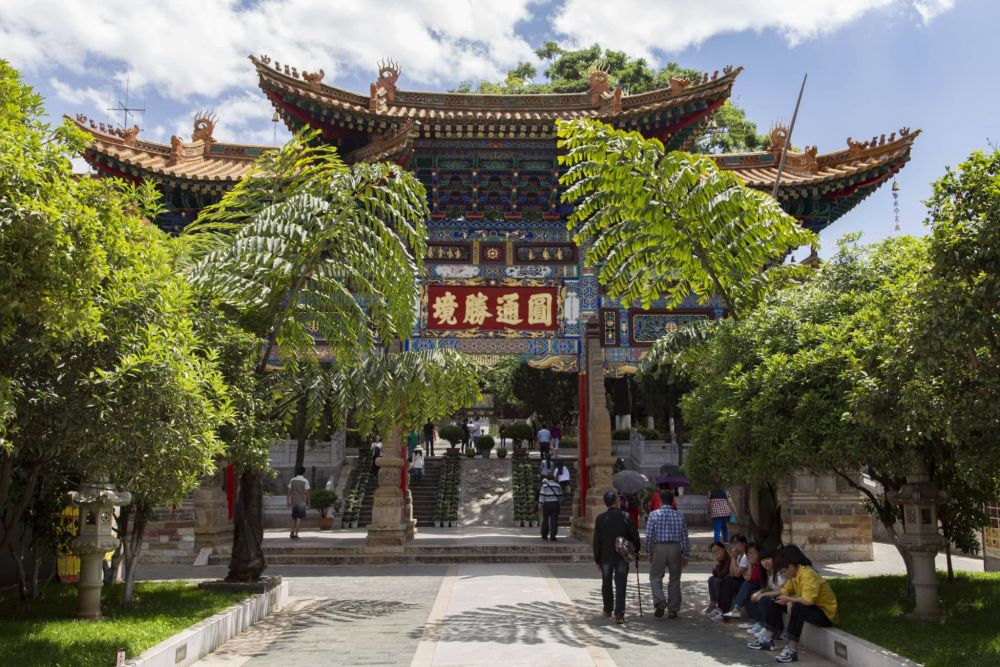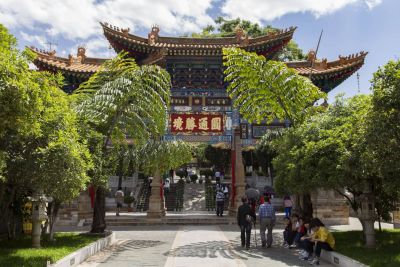

The Stone Forest Scenic Area, known as Shilin in Chinese, is a remarkable set of limestone formations located approximately 85 kilometers from Kunming. Spanning an area of 400 square kilometers, the Stone Forest is touted for its unique karst geography, which has taken millions of years to form. Visitors can wander through the maze of towering pinnacle-like rocks, which evoke a sense of walking through a forest made of stone, hence the name. The region also holds cultural significance, as it is home to the local Sani People, a branch of the Yi minority. Travelers are often treated to traditional folk dances and the chance to browse through handicrafts. Exploring this natural wonder is a must-do for any visitor to Kunming and provides an excellent opportunity to appreciate the blend of natural beauty and cultural heritage.
Dian Lake, also known as Dianchi, is the largest freshwater lake in Yunnan Province and is located just on the outskirts of Kunming. Taking a cycling tour around this lake offers not only exercise but also the chance to take in the beautiful natural scenery and the local way of life. The cycling path, which runs along part of the lakeshore, provides ample opportunities for photo stops and interaction with the friendly local residents. Additionally, there are various attractions along the way, such as parks, temples, and wetlands, where one can learn more about the cultural and ecological significance of the region. The well-paved cycling paths make this activity suitable for all levels of cyclists and provide a refreshing escape from the urban environment of Kunming.
Green Lake Park, also known as Cui Hu Park, is a verdant oasis right in the heart of Kunming. It was once a water reservoir for the city and has now become one of the most beloved parks in the area. Featuring a series relationship with the surrounding water. Also, the park often hosts various cultural events and traditional musical performances. A leisurely stroll or a boat ride on the lake provides a serene experience and the chance to unwind amidst the bustling city life. Many tea houses and outdoor cafés are available for visitors to relax and enjoy the local snacks while soaking up the peaceful atmosphere.
Kunming Zoo, located on Yuantong Hill, is a popular destination for families and animal lovers. It hosts a variety of animals from around the world, including a panda house which is one of the main attractions. Not only does the zoo offer educational insights into the animal kingdom, but it also provides a scenic view of the city from its hilltop location. Just a stone's throw away from the zoo is Yuantong Temple, one of the most important and oldest Buddhist temples in Kunming. With its intricate architecture and tranquil ponds, this temple is a sanctuary for those seeking a moment of peace. Visitors can experience the cultural diversity of Kunming by enjoying these two quintessential attractions in a single day.
The Golden Temple Park, also known as Jindian Park, is a tranquil and picturesque area located on Mingfeng Hill. The centerpiece of the park is the Golden Temple itself, which is China's largest copper temple, cast during the Ming Dynasty. The temple gleams under the sunlight, creating a spectacular sight against the backdrop of lush greenery. The park is filled with camellia and cherry blossom trees, making it especially beautiful in spring when the flowers are in bloom. Visitors can enjoy exploring the various pavilions, archways, and the grand Taoist temple. With fresh air and peaceful surroundings, the Golden Temple Park offers a spiritual retreat and a chance to explore the historical and natural charm of Kunming.
Daguan Park is an expansive cultural and recreational park located in the western suburb of Kunming, by the shores of Dian Lake. The park is famous for the Daguan Pavilion, which stands tall, offering panoramic views of the lake and the Western Hill. The pavilion has a long history dating back to the Qing Dynasty and is inscribed with the 'Daguan Long Couplet,' said to be the longest couplet in China. Visitors can enjoy leisurely walks along the willow-fringed pathways, take a boat ride on the lake, or participate in the local pastime of kite flying. The park becomes particularly lively during festivals, featuring folk performances and local snacks, making it an engaging place to experience the culture and traditions of Kunming.
The Kunming City Museum offers a dive into the rich history and cultural heritage of the region. The museum houses a diverse collection that includes ancient artifacts, bronze sculptures, and historical documents that tell the story of Yunnan's past. The exhibitions are well organized and provide a comprehensive look at the ethnic diversity, historical events, and the development of Kunming. Notably, the museum also features the 'Flying Tigers' exhibit, dedicated to the American volunteer group that aided China during WWII. Visiting the Kunming City Museum is a worthwhile activity for history buffs and anyone interested in getting a deeper understanding of the city's cultural fabric.
The Dongchuan Red Land, located about 250 kilometers northeast of Kunming, presents some of the most strikingly colorful landscapes in China. The red soil, rich in minerals and oxidized iron, contrasts with the patchwork of crops and creates a breathtaking view that photographers dream of. Known as 'God's Palette,' these lands reveal different hues throughout the year, depending on the season and crop cycles. A photography tour to this area not only offers the chance to capture incredible images but also provides a glimpse into the rural life of Yunnan. The journey itself showcases beautiful rural scenery and offers stops at small villages where visitors can connect with the friendly local people.
Jiuxiang Scenic Area is renowned for its extensive system of caves and karst formations. Situated about 70 kilometers from Kunming, Jiuxiang boasts the largest cave group system in China, with splendid stalactites, stalagmites, and underground waterfalls. Visitors take guided tours along well-maintained pathways and bridges, passing through caves like the Lion Cave and the Fairy Maiden Cave. The site also features the Yi ethnic minority group's customs and traditions, showing an aspect of the local human history blended with the natural splendor. For adventure seekers and geological enthusiasts, the Jiuxiang Cave and Karst Network provides an unforgettable experience of nature's underground artistry.
Western Hills, also known as Xishan, is a lush mountainous region on the western outskirts of Kunming, boasting temples, grottoes, and the famous Dragon Gate. This extensive Taoist complex was carved into the cliffs by the Qing Dynasty monk Wu Laiqing and his followers over a period of 72 years. The hike up the hill to Dragon Gate is moderately challenging, with stone stairs and mountain paths, but it is well compensated by the scenic vistas of Kunming and Dian Lake. Along the way, visitors will encounter temples like Huating Temple and Taihua Temple, offering places of interest to explore amidst the tranquility of nature. The Western Hills provide travelers with a perfect blend of culture, exercise, and breathtaking scenery.
